Dosbox: Playing "Tie Fighter"
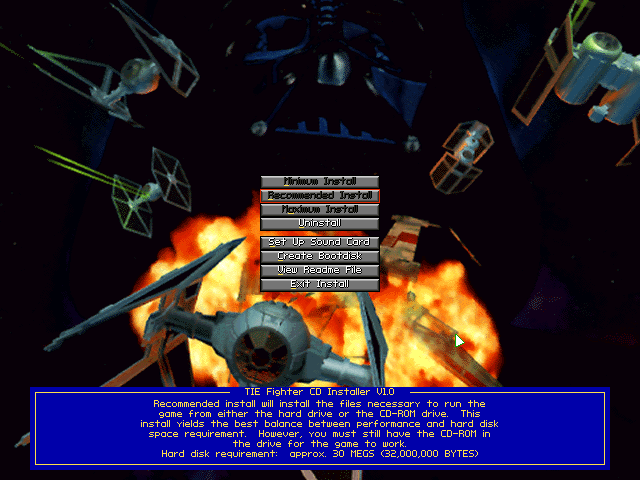 This is how the buttons appeared (blacked out) when I first tried to install the game on Dosbox under Linux. This is how the buttons appeared (blacked out) when I first tried to install the game on Dosbox under Linux. |
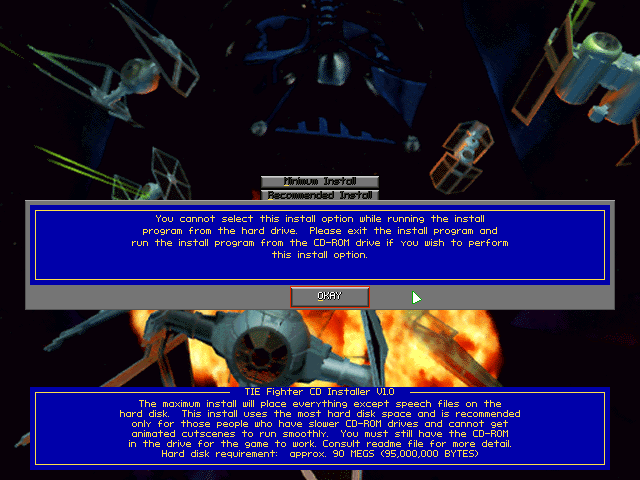 I still clicked on the "Maximum Install", and this is what appeared. I still clicked on the "Maximum Install", and this is what appeared. |
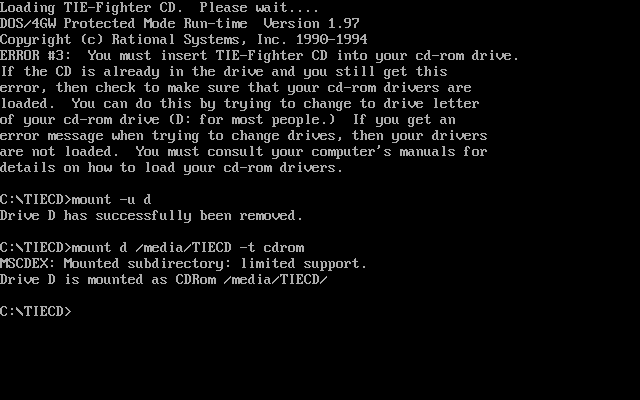 These are the commands I used to properly mount the CD-ROM so that the game would both install and run. These are the commands I used to properly mount the CD-ROM so that the game would both install and run. |
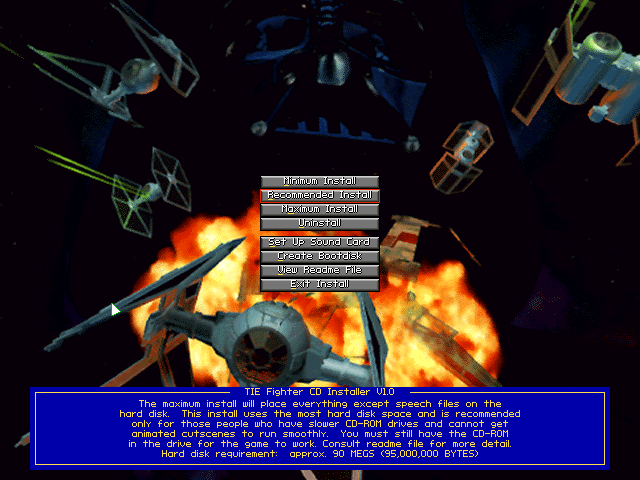 This is the install screen that showed after properly mounting the CD-ROM. Note that the various install buttons are no longer blacked out. This is the install screen that showed after properly mounting the CD-ROM. Note that the various install buttons are no longer blacked out. |
Gary Schafer, 30 January 2013
My last post on playing games on Dosbox talked about getting the joystick working. There's another game that I also wanted to get running. It was LucasArts "Tie Fighter". Unfortunately, every time I tried to install it, it wouldn't work. I'd get the message "You cannot select this install option while running the install program from the hard drive." Well, that's helpful. Not!
I'm running Dosbox on Ubuntu Linux 12.04. Turns out that it was a problem how the CD-ROM was mounted. The easy way to mount the CD drive in Dosbox under Linux is mount d /media/TIECD. But that won't work for this game. The right way to mount the CD drive in order for "Tie Fighter" to work is mount d /media/TIECD -t cdrom. Once I did that, I was able to install the game with no problem, and I've now played the first two missions. Now, when I want to start the game, here are the commands I type into Dosbox (the text in bold is what I actually type):
Z:\>mount c ~/dosprogs
Drive C is mounted as local directory /home/gary/dosprogs/
Z:\>c:
C:\>mount d /media/TIED -t cdrom
MSCDEX: Mounted subdirectory: limited support.
Drive D is mounted as CDRom /media/TIECD/
C:\>cd tiecd
C:\>tie
A Blast from the Past: My New Computer (circa 1999)
Gary Schafer, 29 January 2013 (originally September 1999)
(Note: This is something I wrote and posted on a puny webpage (makes this one look like Scalzi's "Whatever" page by comparison). Kinda gives you an idea on processing power increases we've seen in the past 13+ years.)
Up until July of 1999, I was operating a 486DX machine running Windows 3.1. I didn't need anything more because I had already bought everything I would ever need; I had word processors, graphics programs, HTML editors, and more games than you can shake a stick at.
Unfortunately, nothing lasts forever. My 486 was no exception.
One Saturday, while working in my office, my computer gave off an unnatural whine. Within a few moments, it reset itself. I shut it off, took it apart, and checked it out. The fan on top of the processing chip had clogged with dust and stopped working. Apparently, when the fan stopped working, the chip overheated. When it overheated, it was damaged. Considering that no one produced the chip nor anything similar, there was no way I could repair the system.
I looked at new computer systems. I checked out Micron, Dell, Gateway, CompUSA, and Best Buy. In the end, I wound up at a small computer store called Computer Pharmacy, Inc, which is located in Gambrills, MD. After speaking with the president of the company for a few minutes, I realized this was the company I wanted to build my dream machine. What they built for me was a beautiful system, one for which they should be (and are) very proud. I've put together a little table showing the differences between the old and new system:
| Computer Comparisons |
| Item |
1993 System |
1999 System |
| Processor |
AMD 486DX125 (originally 486DX33) |
450 MHz Pentium III |
| Motherboard |
Daewoo |
Intel 100 MHz motherboard |
| Operating System |
DOS / Windows 3.1 |
Windows 98 (2nd Edition) |
| Power Supply |
LPX w/ motherboard-proprietary connector |
ATX |
| Amount RAM |
32 MB (originally 4 MB of non-parity RAM) |
256 MB |
| Type RAM |
30 pin SIMM - 60 nsec Fast Page Mode DRAM |
168 pin DIMM - PC100 |
| Hard Drive |
Maxtor 2.7 GB (originally Seagate 214 MB) |
IBM 20.7 GB |
| Video Card |
Western Digital 512K IDE |
ATI Rage! 16MB AGP |
| Audio Card |
Soundblaster 16 |
Soundblaster Live! 512V |
| Modem |
Diamond Express 56K |
56K V.90 |
| DVD |
Are you kidding? |
Toshiba 6X DVD-ROM |
| CD-ROM |
Unknown make 8X CD-ROM (added later) |
Sony 24X CD-RW |
| Zip Drive |
External 100 MB |
Internal 250 MB |
| Floppy Drive |
5.25" & 3.5" (originally separate 3.5" and 5.25" floppy drives) |
3.5" |
If you know anything about computers, you know I'm experiencing a world of difference. As I'm typing this, I have a small window open on the desktop with which I am watching "Lost in Space" on DVD. I couldn't do that with my old system...
Oh, the joy of a good computer...
Back from the past. My current system is a quad-core Intel I7 system. To say that this system smokes what I had in 1999 (and the Pentium 4 that I had in between that P3 and now) would be an understatement. The DVD playing has given way to Netflix (on my Sony Playstation 3). Still, this was the system on which I did much game playing. Hours and hours. And hours. But now that I have Comanche 3 working again, oh, let the games begin again!
Dosbox: Playing Comanche 3
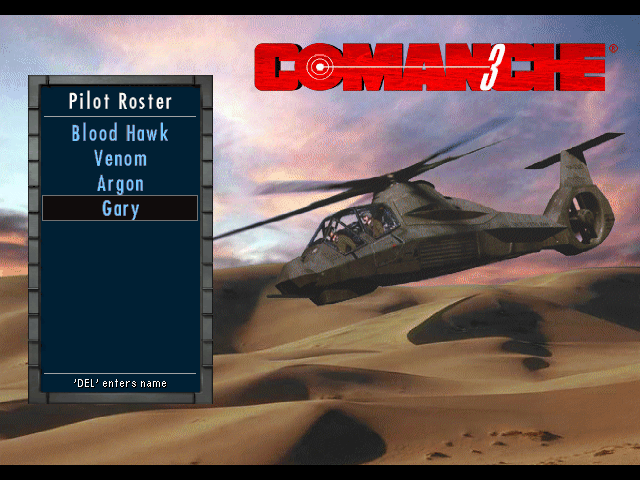 The main screen of the program. The main screen of the program. |
 The mission selection screen. The mission selection screen. |
 Getting ready! Getting ready! |
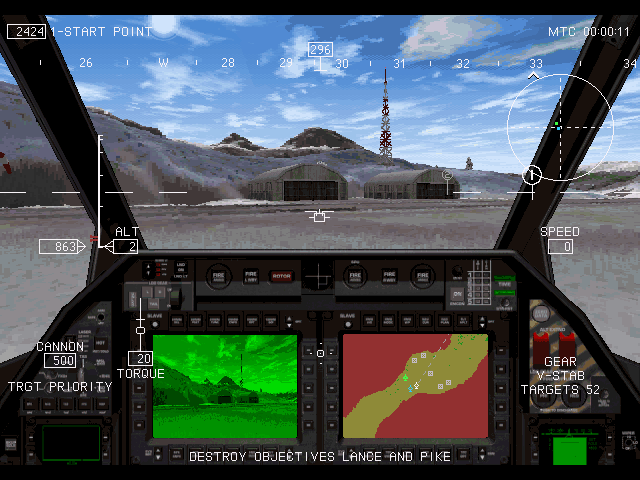 About to take off! About to take off! |
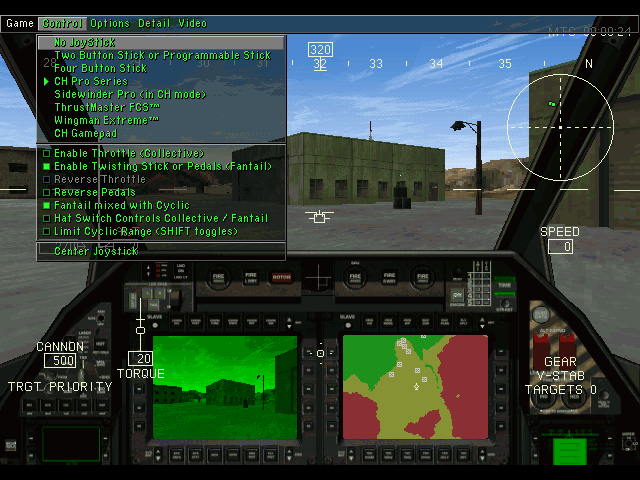 Here are the options within the game itself that I selected for my MS Sidewinder Precision Pro joystick. One of the biggest ones is the last one, "Limit Cyclic Range". Unless you enjoy flying around at 0.2 miles per hour, UNCHECK that box. Here are the options within the game itself that I selected for my MS Sidewinder Precision Pro joystick. One of the biggest ones is the last one, "Limit Cyclic Range". Unless you enjoy flying around at 0.2 miles per hour, UNCHECK that box. |
Gary Schafer, 29 January 2013
I bought a set of Novalogic games several years ago. It was in a 3-CD pack pack entitled, "World of Combat 2000". The games were "F22 Lightning II", "Armored Fist 2", and "Comanche 3". Of these 3, I enjoyed "Comanche 3" or just "C3" the best. I'd played the original Novalogic "Comanche" game (which if I remember correctly came on 6 or 7 floppy disks). I remember it was a bear to get loaded and then get the audio and video settings correct so that I could play it on my old Windows 3.1 machine. Later, when I bought the WoC2000 disk set, it was more for the "Armored Fist" than C3. But it didn't take long to realize that C3 was what I enjoyed most.
I played C3 on a machine I bought in 1999. As a matter of fact, I even posted one of my first web page entries talking about that computer. Bah. That'll be another post. Anyway, I still have the C3 CD. I also have a still-functional joystick, a Microsoft Sidewinder Precision Pro. The problem is that I'm not running Windows (primarily). My primary machine is currently running Ubuntu 12.04. But Dosbox has really impressed me with its current capabilities. Decided to give it a try.
Here's the WS;SR for you: With little effort, I'm playing C3 again as if I have my 1999 machine (running Win98) the day I brought the game home.
There were a few quirks I had to get around. The first was getting the game loaded. When it came time to select the audio, I selected "SoundBlaster 16". For the video, I selected the one that had "VESA 2.0" option. The bigger problem was the joystick, again a MS Sidewinder Precision Pro. The Pro came with a driver CD. The CD also contained a program that let me personalize each of the buttons on the joystick. Of course, that won't work on Linux. Which meant I had to see what I could do with Dosbox.
Dosbox comes with a configuration file. In Linux, it's typically found in the folder "~/.doxbox", where "~" refers to your home directory. The configuration file contains a section called (appropriately enough) "[joystick]". I had to play around with the settings to find the ones that would work both with C3 and with the joystick. Here are my settings (NOTE: I snipped out all of the comments):
[joystick]
joysticktype=ch
timed=false
autofire=false
swap34=false
buttonwrap=false
The last thing I had to do was to figure out which control options within the game would give me the game play I wanted. It's been many years since I last played this game (might be going on 10 years), so I couldn't remember what I had set before. I've finally figured out the best settings for me. And now I'm flying around and BSU (blowing... stuff... up) like it was 1999!
CSS and Background Images
Gary Schafer, 21 January 2013
This post began last night. I was having problems with a background image (code = background-image) and I could not get the image to appear. After playing around with both HTML and CSS, I think I've figured out some of the problems I was having (and there were several problems). Here they are in no particular order:
 The desired background image. The desired background image. |
1) The background-image call must have something with height associated with it. In CSS, a container without any attributes will take on the size of its contents. If there are no contents, then it will effectively have no size. Hence, nothing shows. Here's the first CSS code I attempted to use.
#mainContainer {
background-image: url(testImage.jpg);
}
And here is the HTML code with which I used the CSS code above.
<html>
<head>
<link rel="stylesheet" href="testCode.css" type="text/css">
</head>
<body>
<div id="mainContainer"></div>
</body>
</html>
 The result of having no height associated with the container or anything inside the container. The result of having no height associated with the container or anything inside the container. |
 The result of one line of text inside the container. The result of one line of text inside the container. |
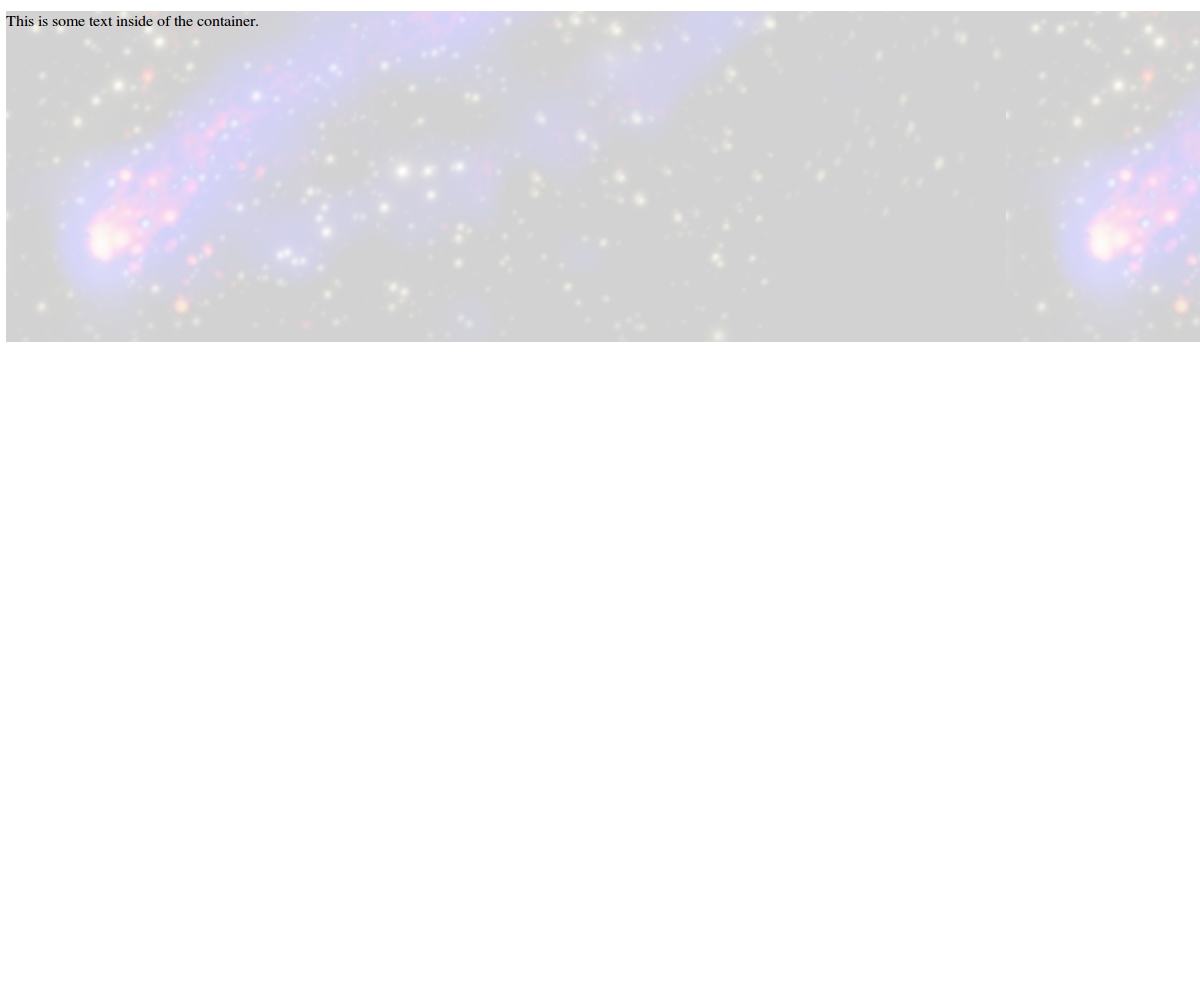 The result of a height attribute for the background image. The result of a height attribute for the background image. |
Without a height associated with the background-image element or without anything inside of the mainContainer ID, the container has effectively zero height. There are two ways to deal with this problem. The first is to put something inside of the container. As an example, we're going to put a line of text inside the container, as follows:
<html>
<head>
<link rel="stylesheet" href="testCode.css" type="text/css">
</head>
<body>
<div id="mainContainer"><p>This is a line of text.</p></div>
</body>
</html>
With this, we get this web page. Note how the height of the background image is only that of the line of text. That's because that is all that is inside of the container.
The second way we can have the background image show is to give the background-image a height attribute, as follows:
#mainContainer {
background-image: url(testImage.jpg);
height: 331px;
}
Note that we do not have to specify a width (the background-image element assumes a 100% width). We only need to specify a height attribute.
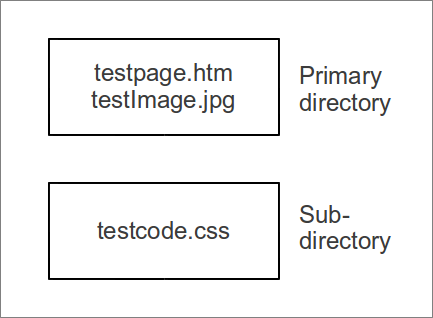 The initial file placement, in which the image did not show up. The initial file placement, in which the image did not show up. |
 The final file placement, in which the image DID show up. The final file placement, in which the image DID show up. |
2) The images called by the background-image code are relative to the CSS file, not the HTML file. This appears to be a quite common mistake.
I loaded the page in my browser (Firefox running on Ubuntu 12.04), the background image didn't show up. Here's where I made my mistake. To the right is a block diagram showing the placement of the different files. Do you see the problem? No? Let me explain. The problem is that the call for background-image is in a different folder than the image it is calling.
Again, in order for the background-image to work, the image location must be relative to the CSS file, not the HTML code. The file placement has to be as shown in the second image on the right.
This also requires an understanding of file placement. When files are called, there are two ways to handle them. The first is absolute file calls, which means that the entire file name has to be stated. For example, in the background-image call above, I could have used background-image: url('http:www.site2241.net/cssCode/testImage.jpg').
The second way is with relative file calls, a call with just the filename. An example would be background-image: url('testImage.jpg'). The file has to be in the same directory as whatever is calling it. Another way to say this is with the code "./" preceding it (e.g. './testImage.jpg'). This says "look in this directory". If you want to go up a directory, use the code "../" (e.g. '../testImage.jpg'). This particular code means "look in the next directory higher for this file". You could also look two directories higher with this command: background-image: url('../../testImage.jpg').
I understand that there might also be browser-specific problems, such as if quotes are used around the filename. I've not seen these problems with Firefox (my primary browser choice) or with Opera. I've also read that some people have issues if there is no position attribute provided in the background-image code. Anyway, I hope this helps someone out there.















